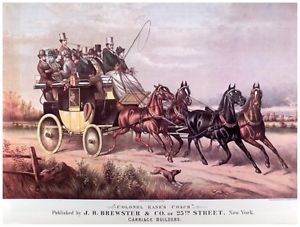From city livery stables to carriage houses on large estates, my great-grandfather was known to drive a four-in-hand team with skill. A career coachman, he came upon his vocation at the turn of the 20th century, when carriage popularity was waning.

My great-grandfather Oscar Nelson drives a well-matched pair on Cortland Street, Sleepy Hollow, New York circa 1910
Last year, a carriage horse and driver took me on a wonderful tour of New York City’s Central Park, which ignited a desire to learn more. And while I may carry coachman’s DNA, I have never taken over the reins from a driver until last week when a friend offered to take me for a drive around my neighborhood with one of her horses pulling a light, two-wheeled ‘buggy.’
Carriages by Brewster & Co.
Carriage making was a major 19th century industry. The Brewster family had vast showrooms filled with Landaus, Broughams and Lady’s Phaetons, with factories in New York City and New Haven dating back to 1810. Brewster & Co. produced beautiful hand-built carriages, even earning a gold medal at the Paris Exposition in 1878. Business boomed for decades as they became known as the “Carriage Builder for the American Gentleman.” Among their customers were Rockefellers, Vanderbilts, Astors and J.P. Morgan, each with their own colored coaches, not to be owned by anyone else. But steam-powered train transportation exploded between the1830s and 1860s and signaled the beginning of the end for the horse-drawn carriages. The end came with a new invention called the “horseless carriage” during the Gilded Age.
By 1896, the first electric car was built by Brewster & Co, and by 1905 the company had ceased making horse-drawn carriages in favor of automobile bodies. But even then, the custom-made “coaches” couldn’t compete with mass-produced automobiles and in 1925 Brewster & Co. was sold to Rolls Royce of America.
William Brewster, Brewster & Co.s final president had a daughter named Barbara Brewster Taylor who lived in Southport, CT. Each year she would graciously open her estate – surrounded by natural jumping obstacles simulating a fox hunt – to host the Fairfield County Hounds annual hunter trials up until the late 1970s. I remember the gracious white-haired lady would come to watch occasionally. All I knew at the time as a teenager was that her father made “world-famous carriages and buggy whips.”

An 1887 Park Drag Brewster Carriage pulled by a team of fine carriage horses, possibly Cleveland Bays
Royal Coaches
Despite progress, you can still find the world’s largest collection of working coaches and carriages at London’s Royal Mews at Buckingham Palace. Among them are the gilded, golden Coronation Carriage built for Catherine II and the sleek, black Glass Coach, my favorite when I visited the Mews, which carried Lady Diana Spencer to Westminster Abbey on her wedding day in 1981. Another popular open carriage, drawn by six of the Queen’s horses, is the 1902 State Landau which carried Kate and William, Duke and Duchess of Cambridge, back to Buckingham Palace after their wedding in 2011.
Driving Versus Riding Horses
Sitting in the two-wheeled buggy I felt like royalty as we headed down the road. “Clip-clop, clip-clop, clip-clop,” sounded the hooves striking pavement. Feeling the motion of a small carriage is very different than horseback riding. A rhythmic bounce that can be softened by bracing your feet against the carriage floor and pushing your back into the seat. Before my friend turned over the reins, we had a safety lesson. “Always wear your seatbelt,” she told me. A little loop at the end of the reins placed over your pinkie finger. “The last thing you want to do is lose your reins while driving a carriage!” “Don’t stick your hands near the moving wheels or you will break your arm.” All valid points.
Carriage horses are trained by voice to “walk on,” “trot,” “walk,” “whoa,” “stand,” and my favorite, “come around.” This last maneuver moves a carriage on a turn, the horse executing a side-step, leg over leg turn on the haunches to turn a carriage left or right. Unlike riding where you have your seat and your legs, you only have a few aids left to control your horse: your hands, your voice and the fabled buggy whip.
Easily I got the hang of using my hands. The long reins held between the pointer and index fingers to drive a horse versus between the thumb and index finger while riding. The mechanics of steering, turning and stopping were executed with a stronger bit. And, just like riding, when you are on the road, and a big, loud, scary yellow school bus comes barreling down the road behind you, focusing your horse’s attention on anything but the school bus is paramount. You focus on the gait, “Walk on.” You point the horse’s head away from the impending confrontation. You hold your breath! And when the bus followed by eight cars passes, you tell the horse, “Good Boy!”
Despite the slow speed of a horse-drawn carriage compared to today’s cars, they can be dangerous places as horses can be unpredictable, and occasionally, will bolt despite being harnessed to a large wooden structure. “Always have an exit strategy,” was part of the safety lesson. If you don’t, you can get seriously injured, as evidenced by many carriage accidents with runaway horses recounted in The Bee’s ‘Way We Where’ from 100 years ago. This time, however, I got a delicious taste of a bygone era, when horses pulled carriages and people needed them to explore and discover their world, at a much slower pace. The sky, the fields, the trees, the flowers, the birds, all came into view on their own, just waiting for my discovery.








